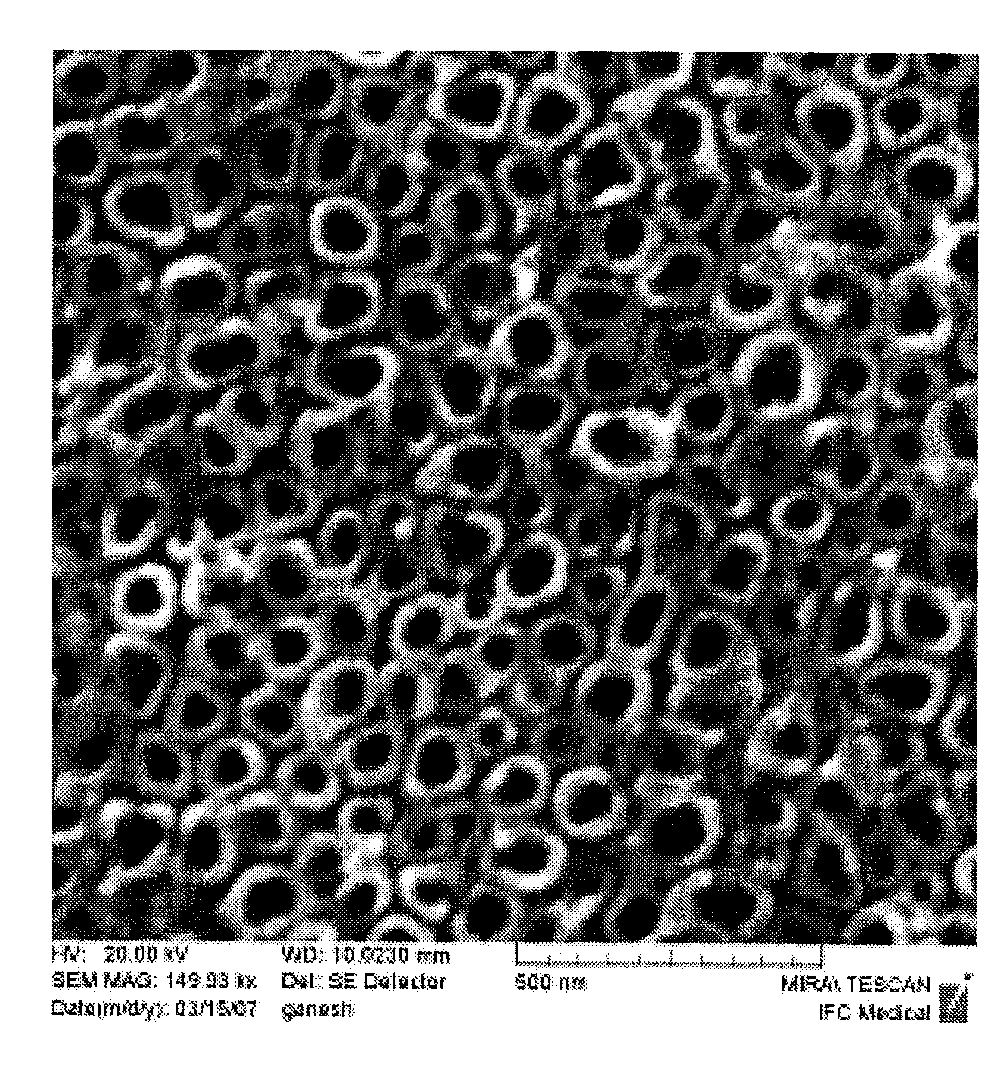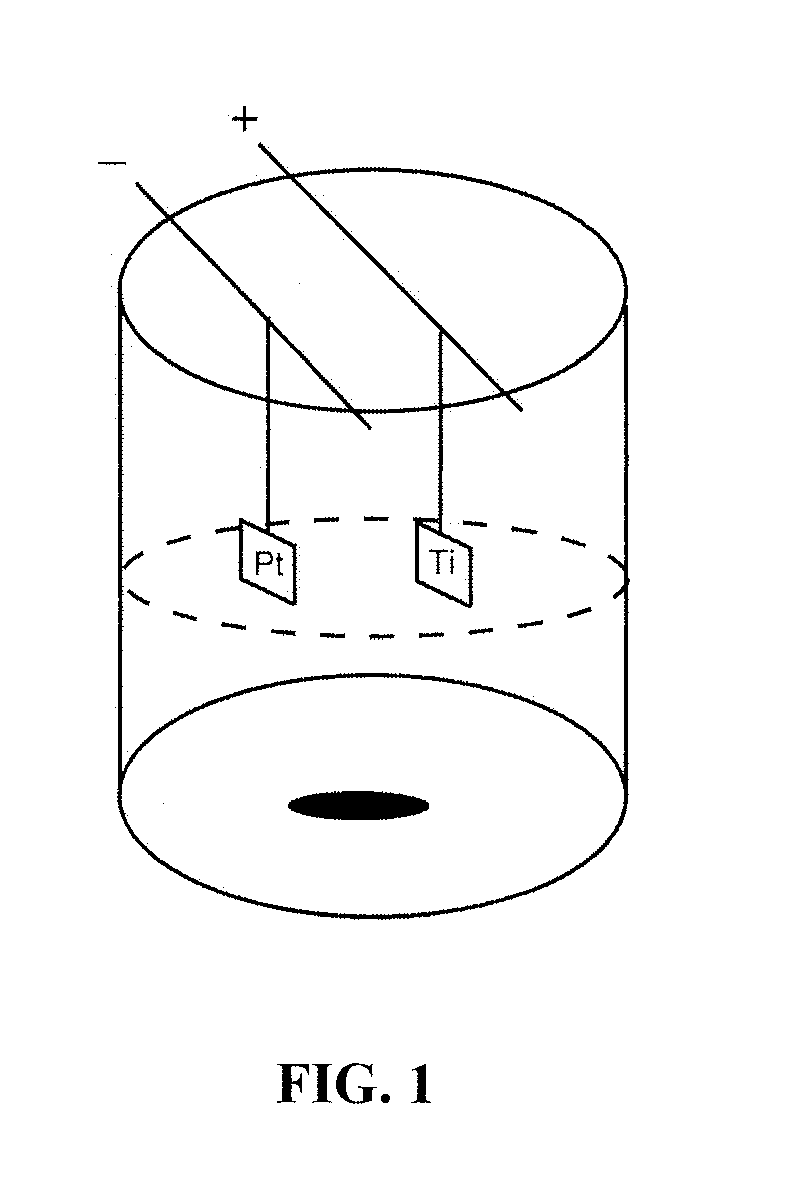Biocompatible Coated Nanostructured Titanium Surfaces
a nano-structured titanium and biocompatible technology, applied in the field of biomaterials, can solve the problems of insufficient practical use, unpredictable cell/tissue adhesion, and long-term failure of titanium implants, and achieve the effect of strengthening bone growth and strong cell adhesion
- Summary
- Abstract
- Description
- Claims
- Application Information
AI Technical Summary
Benefits of technology
Problems solved by technology
Method used
Image
Examples
example 1
Anodized Titanium
[0089]A standard anodization apparatus utilizing a platinum cathode and titanium anode connected by copper rods to a power supply was employed (FIG. 1). The beaker is Teflon® or other material impervious to the acid.
[0090]Rectangular shaped titanium foil with a thickness of 250 μm (99.7%; Alfa Aesar) was cleaned ultrasonically with ethanol and water prior to anodization. Cleaned substrates were etched with a mixture of 1M HNO3 (Aldrich) (with few drops of HF solution) and further cleaned with deionized water. Afterwards, pretreated specimens were anodized in a 1.5% hydrofluoric acid (HF) solution. Using a DC power supply, a 20 V anodizing voltage was applied for 10 minutes. During processing, the anode and cathode were kept parallel with a separation distance of about 1 cm. Specimens were rinsed with deionized water and dried with nitrogen gas immediately after being anodized. Before osteoblast adhesion was performed, specimens were sterilized under UV for 1 hr in a...
example 2
Molecular Plasma Deposition Apparatus
[0102]The deposition apparatus includes a vacuum chamber with a small aperture, and a small bore, metallic needle connected to a tube connected to a reservoir holding a liquid suspension or solution of the material desired to be deposited. The reservoir is at atmospheric pressure. A power supply with the ability to supply up to 60 kV can be employed; however, the voltage attached to the needle is typically −5000 volts to +5000 volts. A substrate inside the vacuum chamber, is centered on the aperture with a bias from −60 kV through −60 kV, including ground. The apparatus is illustrated in FIG. 3A.
[0103]Another molecular deposition apparatus is illustrated in FIG. 3B. This is a modification of the apparatus in FIG. 3A such that the needle, tube, and reservoir are disposed in an enclosure that excludes air, but allows for the controlled introduction of other gases. Optionally selected gases include argon, oxygen, nitrogen, xenon, hydrogen, krypton, ...
example 3
Osteoblast Cell Adhesion to Anodized Titanium
[0105]Human osteoblasts (CRL-11372 American Type Culture Collection, population numbers 7-8) in Dulbecco Modified Eagle Medium (Gibco) supplemented with 10% fetal bovine serum (Hyclone) and 1% Penicillin / Streptomycin (Hyclone) were seeded at a density of 3500 cells / cm2 onto an anodized titanium substrate and placed in standard cell culture conditions (humidified, 5% CO2 / 95% air environment) for 4 hr. The substrate was rinsed in phosphate buffered saline to remove any nonadherent cells. The remaining cells were then fixed with formaldehyde (Aldrich Chemical Company, USA), stained with Hoescht 33258 dye (Sigma), and counted under a fluorescence microscope (Leica, DM IRB). Five random fields were counted per sample substrate. All tests were run in triplicate and repeated at least three separate times. Standard t-tests were used to check statistical significance between means.
[0106]Results showed significantly increased (p<0.01) osteoblast ad...
PUM
| Property | Measurement | Unit |
|---|---|---|
| Diameter | aaaaa | aaaaa |
| Diameter | aaaaa | aaaaa |
| Diameter | aaaaa | aaaaa |
Abstract
Description
Claims
Application Information
 Login to View More
Login to View More - R&D
- Intellectual Property
- Life Sciences
- Materials
- Tech Scout
- Unparalleled Data Quality
- Higher Quality Content
- 60% Fewer Hallucinations
Browse by: Latest US Patents, China's latest patents, Technical Efficacy Thesaurus, Application Domain, Technology Topic, Popular Technical Reports.
© 2025 PatSnap. All rights reserved.Legal|Privacy policy|Modern Slavery Act Transparency Statement|Sitemap|About US| Contact US: help@patsnap.com



